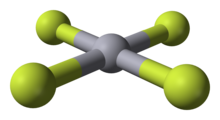This is the current revision of this page, as edited by AnomieBOT (talk | contribs) at 16:31, 21 December 2024 (Dating maintenance tags: {{Cn}} {{Failed verification}}). The present address (URL) is a permanent link to this version.
Revision as of 16:31, 21 December 2024 by AnomieBOT (talk | contribs) (Dating maintenance tags: {{Cn}} {{Failed verification}})(diff) ← Previous revision | Latest revision (diff) | Newer revision → (diff)
| |

| |
| Identifiers | |
|---|---|
| 3D model (JSmol) | |
InChI
| |
SMILES
| |
| Properties | |
| Chemical formula | HgF4 |
| Molar mass | 276.58 g/mol |
| Except where otherwise noted, data are given for materials in their standard state (at 25 °C , 100 kPa).
| |
Mercury(IV) fluoride, HgF4, is a purported compound, the first to be reported with mercury in the +4 oxidation state. Mercury, like the other group 12 elements (cadmium and zinc), has an sd electron configuration and generally only forms bonds involving its 6s orbital. This means that the highest oxidation state mercury normally attains is +2, and for this reason it is sometimes considered a post-transition metal instead of a transition metal. HgF4 was first reported from experiments in 2007, but its existence remains disputed; experiments conducted in 2008 could not replicate the compound.
History
Speculation about higher oxidation states for mercury had existed since the 1970s, and theoretical calculations in the 1990s predicted that it should be stable in the gas phase, with a square-planar geometry consistent with a formal d configuration. However, experimental proof remained elusive until 2007, when HgF4 was first prepared using solid neon and argon for matrix isolation at a temperature of 4 K. The compound was detected using infrared spectroscopy.
However, the compound's synthesis has not been replicated in other labs, and more recent theoretical studies cast doubt on the possible existence of mercury(IV) (and copernicium(IV)) fluoride. Dirac-Hartree-Fock computations including both relativistic effects and electron correlation suggest that an HgF4 compound would be unbound by about 2 eV (and CnF4 by 14 eV).
Explanation
Theoretical studies suggest that mercury is unique among the natural elements of group 12 in forming a tetrafluoride, and attribute this observation to relativistic effects. According to calculations, the tetrafluorides of the "less relativistic" elements cadmium and zinc are unstable and eliminate a fluorine molecule, F2, to form the metal difluoride complex. On the other hand, the tetrafluoride of the "more relativistic" synthetic element 112, copernicium, is predicted to be more stable.
Subsequent density functional theory and coupled cluster calculations indicated that bonding in HgF4 (if it really exists) involves d orbitals. This has led to the suggestion that mercury should be considered a transition metal (the group 12 metals are sometimes excluded from the transition metals because they do not oxidize beyond +2). Chemical historian William B. Jensen has argued that the compound alone is insufficient to reclassify the metal, because HgF4 represents at best a non-equilibrium transient state.
Synthesis and properties
HgF4 is produced by the reaction of elemental mercury with fluorine:
- Hg + 2 F2 → HgF4
HgF4 is only stable in matrix isolation at 4 K (−269 °C); upon heating, or if the HgF4 molecules touch each other, it decomposes to mercury(II) fluoride and fluorine:
- HgF4 → HgF2 + F2
HgF4 is a diamagnetic, square planar molecule. The mercury atom has a formal 6s5d6p electron configuration, and as such obeys the octet rule but not the 18-electron rule. HgF4 is isoelectronic with the tetrafluoroaurate anion, AuF
4, and is valence isoelectronic with the tetrachloroaurate (AuCl
4), tetrabromoaurate (AuBr
4), and tetrachloroplatinate (PtCl
4) anions.
References
- Is mercury a transition metal? Archived 2016-10-12 at the Wayback Machine
- Rooms, John F.; Wilson, Antony V.; Harvey, Ian; Bridgeman, Adam J.; Young, Nigel A. (2008). "Mercury–fluorine interactions: a matrix isolation investigation of Hg···F2, HgF2 and HgF4 in argon matrices". Phys. Chem. Chem. Phys. 10 (31): 4594–4605. doi:10.1039/B805608K. PMID 18665309.
- "High Oxidation States: Mercury tetrafluoride synthesized". Archived from the original on 2011-07-19. Retrieved 2008-06-26.
- "Elusive Hg(IV) species has been synthesized under cryogenic conditions". 2007-10-12.
- Malli, Gulzari L. (2013-03-09). "Relativistic quantum chemistry of heavy and superheavy elements". In Brändas, Erkki J.; Kryachko, Eugene S. (eds.). Fundamental World of Quantum Chemistry: A Tribute to the Memory of Per-Olov Löwdin. Vol. III. Springer. p. 348. doi:10.1007/978-94-017-0448-9_16. ISBN 9789401704489.
- Hoffman, Darleane C.; Lee, Diana M.; Pershina, Valeria (2006). "Transactinides and the future elements". In Morss; Edelstein, Norman M.; Fuger, Jean (eds.). The Chemistry of the Actinide and Transactinide Elements. Vol. III (3rd ed.). Dordrecht, The Netherlands: Springer Science+Business Media. doi:10.1007/1-4020-3598-5_14. ISBN 1-4020-3555-1 – via Academia.edu.
- Wang, Xuefang; Andrews, Lester; Riedel, Sebastian; Kaupp, Martin (2007). "Mercury Is a Transition Metal: The First Experimental Evidence for HgF4". Angew. Chem. Int. Ed. 46 (44): 8371–8375. doi:10.1002/anie.200703710. PMID 17899620.
- Jensen, William B. (2008). "Is Mercury Now a Transition Element?". J. Chem. Educ. 85 (9): 1182–1183. Bibcode:2008JChEd..85.1182J. doi:10.1021/ed085p1182.
| Mercury compounds | |||
|---|---|---|---|
| Mercury(I) | |||
| Mercury(II) |
| ||
| Mercury(IV) |
| ||
| Amalgams | |||
| Mercury cations | |||